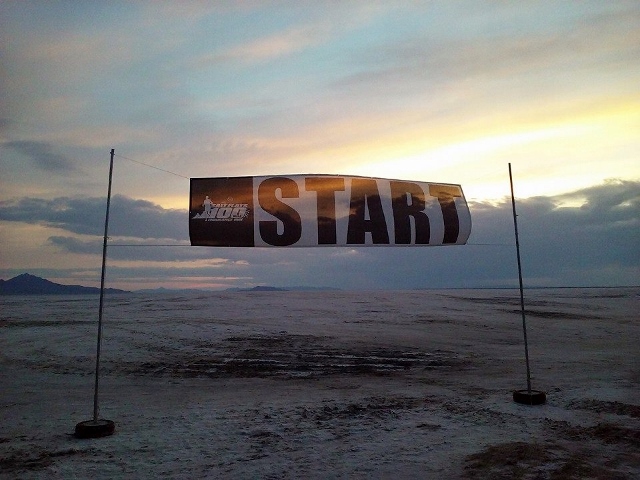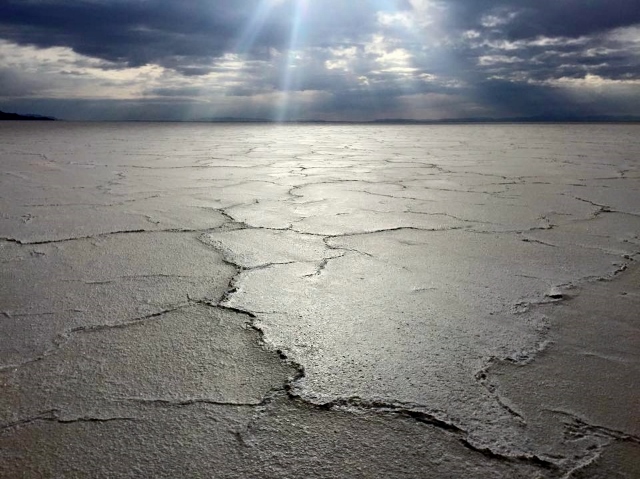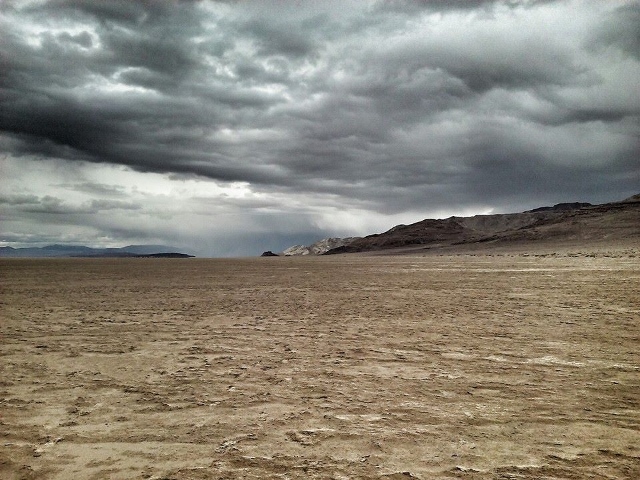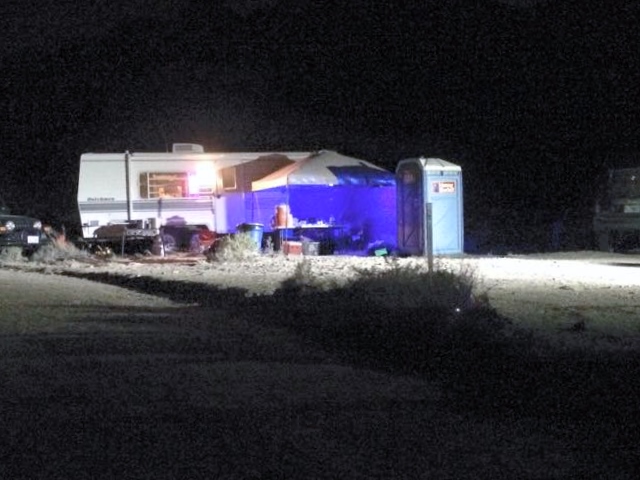 For the fourth time I went to run the Salt Flats 100 near Wendover, UT/NV. I really like the course which combines speed with some serious challenges. The Salt Flats 100 (and 50) starts on the historic Bonneville Salt Flats Speedway. The actual salt flats are 12 miles long and 5 miles wide covering just over 46 square miles. Near the center, the crust is 5 feet thick in places. That is 147 million tons of mostly table salt! It is the site of some astounding land speed records of more than 600 mph.
For the fourth time I went to run the Salt Flats 100 near Wendover, UT/NV. I really like the course which combines speed with some serious challenges. The Salt Flats 100 (and 50) starts on the historic Bonneville Salt Flats Speedway. The actual salt flats are 12 miles long and 5 miles wide covering just over 46 square miles. Near the center, the crust is 5 feet thick in places. That is 147 million tons of mostly table salt! It is the site of some astounding land speed records of more than 600 mph.

The course then runs along the foothills of various “islands” above the salt, up and over six significant passes. This is an “easier” 100, but not a flat run. You climb about 6,000 feet along the way. It has a very generous cutoff time, so is great for first-timers or slower runners.
This year, I would be running the 100 with my older brother, Bob who has a finished a couple 100s in the past. He was determined to finish this race which he DNFed a couple years ago at about mile 60. We toed the start line with 42 100-milers and a bunch more 50-milers. (The 50-mile runners would share the same course with us for the first 22.5 miles.

We were away at 7 a.m. running across the historic salt flats aiming toward Floating Island 15 miles away that would seem to never get closer. (In the afternoon from I-80, if you look north, this “island,” a small mountain, seems to float in the sky because of a mirage effect). Last year for the first seven miles I led the pack, but this year Bob and I started with a quick pace but others kicked up the speed. I enjoyed talking with several runners along the way.

For the first five miles we kept a pace of about 9:30 but then started slowing. At times I would push on ahead of Bob but then slow so he would catch up. The pace was comfortable and let me enjoy the morning and talk to others. We reached the Speedway aid station (mile 10.3) at 1:41 and reached Floating Island (mile 15.8) at 2:49 in 20th place. I was 26 minutes behind my quick pace from last year. I stopped to fix a shoe problem. A piece of tape in my shoe was loose and starting to cause a blister.

Next up was a run on a dike to reach Silver Island. Along the way I walked with Quin Barney for a while. It was good rest and talk. I then bid goodbye and ran ahead to catch back up with Bob. Even though the morning was cool, he had not been drinking enough so I encouraged him to get the fluids pumping.
We reached Cobb Peak Road (mile 22.5) in 4:20. Bob’s pace was struggling. He made a long bathroom break and as we were going to start again, I told him I would run the first hill climb fast and then wait for him. He told me that I should just go run and not wait for him. My legs felt so rested and I did long to start pushing hard, so we agreed that I should ditch him.
I considered that this would be an interesting experiment. Usually I start 100s pretty fast, and this time I held back significantly for the first 22.5 miles. Now I was ready to push hard. Would I see a difference overall? I was now in 20th place and an hour behind my pace from last year. I loved the idea of trying to see how many runners in front of me that I could pass.
Next up was a 1,200-foot climb in 3.1 miles. After all those flat miles, I really looked forward to trying to run this climb fast. Last year I ran it fast and pulled into the overall lead near the top and held on to that lead for another 20 miles. This year I kicked it into gear and tried to keep a steady pace of at least 12:00 all the way to the top. I first passed Emily Berriochoa from Idaho who was running very well. As I made the next turn, there were others to catch. I passed two more runners and ran every single step to the top, running this section in only 36 minutes. I was very pleased with my uphill strength.

Now, on the other side of Cobb Peak Pass was a rocky road descent with a great view of salt plains in the distance. I pushed the pace but not quite as fast as I did last year when my first-place adrenaline was flowing. But in this next six miles, I overall my time for this segment was exactly the same as last year. My rested legs were working well. I passed three more runners on the downhill. Once on the smoother Silver Island Road, it ascends gently up to Hastings Pass. I was very surprised that another runner who I passed kicked it into gear and was keeping up with me. The first spring storm of the day hit with a mile to go to the aid station. The wind really kicked up and the rain soaked my front side. But the temperature didn’t drop enough to be uncomfortable. I arrived at Hasting Jct (mile 31.5) at 6:06, still an hour behind last year’s pace, but I had pulled into 14th place. Behind me, Bob was doing fine, he would arrive there in 34 minutes. The leader of the race was an amazing 1:45 ahead.
Things were going very well and I still felt great. The rain storm passed, but I stuffed a garbage bag poncho in my pocket for additional passing storms. (I would never put it on). Next up was a long 19-mile loop around Crater Island to the north. Within the first mile, I passed two more runners who were running pretty hard and they would push me for the next several miles to stay ahead. There were some good climbs on the island and I did my best to run nearly every step. I couldn’t see any other runners ahead. (They had left the aid station 15 minutes earlier so were more than a mile ahead of me.)
I reached the north end of Crater Island, Sheep Camp (mile 39.9) at 7:54, now in 12th place. I had lost some time to my last year’s pace and was 1:09 behind. Fatigue was starting to set in. The next section is one of the toughest portions of the course, that includes a five-mile mud flats run off the shore of Crater Island. But this year, because of passing storms the flats seemed a bit firmer and less sandy. I pushed to keep up a consistent pace. I had run on miles, and miles of sand during the past couple months at Antelope Canyon 100 and Monument Valley 100. There, I had learned how to run on sand fast. I was surprised that a similar technique worked very well on these flats and it felt much easier then past years. Looking ahead I could make out a couple runners but they seemed to be nearly two miles ahead.

Usually the heat can be a killer on these flats but this year it was windy for me. As a storm approached, a south headwind would make things rough, but then it would shift from the northwest and push me forward. I was able to dodge the storm, just getting some sprinkles on my back side. Looking behind, I was keeping about a half mile ahead of a runner behind (Tristan Newkirk).
With a half mile to go on the loop I was feeling fantastic, singing to music, and pushing a nice pace. I reached the 50-mile mark at about 10:15. I arrived back at Hastings Jct (mile 50.4) at 10:24, still in 12th place, now 1:15 behind my last year’s pace. But last year I felt hammered at this point and had a long stop to recover. This year I felt great. I was very surprised to see three runners who had been nearly two miles ahead of me still at the aid station. They had stopped for nearly 30 minutes and when they saw me arrive, all three quickly left.
Anne Watts was there and I asked how Bob was doing. She said he was doing fine. I felt a little guilty ditching him, but I knew that running faster would be much easier on me than a slow pace. He would reach this point in 1:23. He was holding his pace well, still in 20th place.
Next up was a long pounding dirt road run on Silver Island road for the next 11 miles. Elise Maguire and Juan Caballero left the aid station a few minutes ahead of me. I almost caught up but each time they pushed ahead hard and maintained their lead well. I kept my eyes on the storms to the north and west. They looked threatening, but I dodged them all. At times the wind would really kick up and one time I could see a dust cloud blowing across the island. This 11-mile section with two aid stations was just a grind, attempting to keep the pace up. The runners ahead of me pushed their leads.
I arrived at Ghost Dog (mile 57.2) at 11:53 and Silver Island Pass Rd (mile 61.5) at 13:07 exactly one hour behind my pace of last year. So, despite my much slower start for the first 22 miles, I had not been able to use that restful start to gain any time on my fast start the previous year. My pace for the past 40 miles turned out to be about the same.
As I arrived at the station, Richard Camerik was still there and quickly left when he saw me. (Before I started running hard starting at mile 22, he was 47 minutes ahead of me). I grabbed my green light for the night as dusk was approaching. The wind was pretty bad at this point and just like last year, as I turned west, it really helped blow me up and over Silver Island Pass. I loved running up the hill. At the top I caught up with Richard but he pushed the downhill pace to the other side of the island very well and we turned on our lights with a mile to go to the next station.

I was in great spirits as I arrived at Jeep Trail (mile 67) at 14:19 (9:19 p.m.). I was pretty close to my pace two years ago. The Patinos were the station captains and they were kind and quickly took care of me. The three runners ahead, Richard, Elise, and Juan quickly left when I arrived. I did observe that all three of them spent a long time at each aid station, 10-15 minutes. I spent three minutes at this one.
Now, with a fun rough climb ahead that each year I had pushed hard, I was determined to pass these runners for good. I caught Richard immediately, and within the first mile caught both Elise and Juan who were walking. I kept a consistent trot up the hill. Juan greeted me and did his best to match my run, doing well. But in the dark, the flags were hard to see and I missed a turn, continuing to run up a wash. After nearly a half mile, I stopped and told Juan that I thought were off course. Below I could not see the lights of Elise and Richard. I led Juan cross country to where I thought the right road should be and eventually the lights of the other two runners helped us get back on course together. We were all four together at the top of the pass. I didn’t stay around to chat and ran on ahead. By the time I reached Silver Island Road again, I was about a quarter mile ahead. All three couldn’t match the downhill pace on the rough road.
Now again on the grinding dirt road I pushed on ahead for another couple miles until reaching Rock Pile aid station (mile 74.3) at 16:12, now in 8th place. I had also passed a runner who had dropped out at the last station. This station had been hit hard by the wind and had all their tables covered in tarps with big rocks on the table. It was frustrating not being able to grab anything fast and they couldn’t find the things I asked for, but I understood. I really had enough in my pockets for the next section. As the others arrived, I quickly left. All three of them stayed for about 15 minutes giving me a chance to push a lead of a mile. It looks like Elise (the lead woman runner) was struggling and I believe she stayed there for about three hours.
Crew cars came up from behind, making the drive around the south end of the island to greet their runners on the other side. Many encouraged me on. But once I made the turn to the east on a descending paved road, all was quiet. I couldn’t see any runners ahead. (The next closest had about a two mile lead.) Soon, away from the island, I could see the lights of runners and crew cars far behind. I flashed my green light at them, knowing that it could be seen clearly for miles. I wondered how Bob was doing. (He was doing fine, about 12 miles and three hours behind). I could see what looked like two runner lights about a mile behind me.
I arrived at the Nevada aid station (mile 80.6) at 17:59 (12:59 a.m.). This aid station was manned by a scout troop and I chuckled as the leader had to keep the boys from playing with the fire. He mentioned that the two runners ahead of me were both very cold, but I was still feeling comfortable in a wind breaker and shorts. I commented that as long as I kept running and avoiding walking I was doing fine. I did put another jacket around my waist. I was now just 53 minutes behind my last year’s pace, but comparison from this point isn’t fair because last year the terrible cold storm was pouring at this point and blew up the pace for the rest of that race.
What do I conclude about the effects on me starting a race fast or slow. Clearly starting fast for me gets me ahead and I can hold on. Despite my restful first 22-mile start, I was unable to catch up to my pace for last year, even with very similar weather conditions for those miles. But there was one very important difference. This year my stomach felt much better and my overall energy was better at this point in the race. I was also almost exactly on my 2013 pace at this point and I hoped to at least beat that time, my PR for this course.
Away I went into the dark, heading deeper into Nevada before a sharp turn to return in 2.3 miles. I quickly caught up to another runner light. It was Logan Beaulieu. His quads were trashed and was going to have to walk the rest of the way. I wished him well. I made the important turn and hoped that Bob would know to turn. It was marked well. (Somehow Bob would miss it and head several more miles down the road until some kind guy in a truck knew he was off course, bringing him back to the turn.)
Now, was a long eight-mile uphill, one of the toughest parts of the course because of the long distance between aid stations this late in the race. At night it is nice because you can clearly determine where the runners behind you are. I could see that Richard and Juan were less than a mile behind and keeping pace with me. Soon I really started to struggle. My stomach complained because it was hungry. I ate nearly everything in my pockets, but that still wasn’t enough. This section was just too long. My pace slowed. I started to get very drowsy and eventually had to lie down by the trail for a few minutes to rest my eyes and bring my respiration and heart rates down.
I finally reached Utah aid station (mile 89.7) at 20:35 (3:35 a.m.). I was now in 7th place. I only had an 11-minute lead now on Richard and Juan. At this station were 12 volunteers all cheery, who all were very eager to help me. They lifted my spirits, gave me extra special attention as I tried to gain my energy back. When one of them commented that a couple runners were approaching I quickly picked up my things and left.
After another short climb, I knew it would now be almost all downhill and then five miles of flat to the finish. My feet at this point were holding up well and I had a nice downhill pace. I was well down the valley when the lights of Richard and Juan appeared about a mile behind. The finish was now about eight miles away and I knew that I had this one in the bag. I carefully kept an eye on where those guys were.
I reached the final aid station with five miles to go, and pushed on toward the salt flats. With four miles to go, still in the dark, I turned right too soon, running along a canal instead of the dike road. That wasted about five minutes, but I returned and now was running the final four miles. I checked my watch and noticed that Richard and Juan were less than a mile behind now. A crew car was leap-frogging them, helping me determine if they were catching up. I turned off my light so I wouldn’t give them any more motivation. A faint glow growing in the sky was enough with the white salt surface to let me run without light. I kept worrying about getting caught at this point so it pushed my pace at times under 10:00 pace. Signs along the way indicated how far it was to the finish. With a mile to go, I knew I wouldn’t be caught.
Vince Romney, the race director called out my name at the finish line in the growing dawn light. I finished in 23:28, just one minute faster than my best time here two years ago. It was good to finish and I felt amazingly well. This was my 5th 100-mile finish for the first four months of this year and my 68th career 100-mile finish. I finished in 7th place. I felt very good about that, considering that at one time I was in 20th place.
After a quick recovery, I asked about Bob. As far as they knew, he was still in the race. (At that point Bob was off course in Nevada, about 20 miles from the finish). I quickly got in my car, cleaned up a bit and headed to the Nevada aid station to check on his status. The online results were no longer being updated because of Ham radio repeater problems. They let me know that he had been there a few hours earlier. I next drove to about mile 93 to nap and wait for him. After a couple more hours, I was feeling good so I decided to hike the course backward and look for him. Jester Ed soon came and told me that Bob was about a mile behind with a sore back, doing the ultrarunner lean. I ran up the hill and found him. He looked fine, in bad pain, but walking at a good pace.
For the next few hours I drove along leap-frogging him. At times he would lie down on the salt to rest his back and I would pull him to his feet. It looked like agony, but he plodded on. He crossed the finish line in 31:10, in about 20th place. Since I ditched him, overall he had maintained his placing.
My race went very well. As Kelly Agnew once said, any 100-mile finish in the dark is a very good finish. And at age 56, any finish in under 24 hours is very good, and I was the first runner over 50 to finish. I only had one tiny blister that I never noticed and no injury. Bob’s feet on the other hand were thrashed with some bad blisters. I made sure that he recovered OK and got him to a Wendover motel, getting him food and helping him get through the pain. After more than 12 hours of sleep, we both felt much better and made our way back home.
Salt Flats 100 is a super race. Vince puts in a ton of work into it to make it a special event. If you haven’t run it yet, put it on your calendar.



